How NCC keeps grasslands healthy
Range health assessments are a key tool guiding grassland management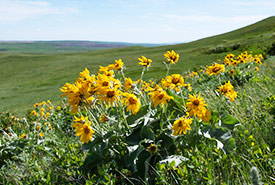
Arrowleaf balsamroot on grazed prairie grassland (Photo by Leta Pezderic)
Home on the range might be where the deer and antelope play, but it is where cattle work.
The Nature Conservancy of Canada (NCC) helps manage thousands of hectares of grasslands across the Canadian Prairies. These threatened ecosystems were shaped over thousands of years by the impacts of roaming mammals, especially bison. But after bison populations were hunted to near extinction in the 19th century, domestic cattle became the dominant grazing animals on the prairies.
Today, cattle largely replicate the grazing pressure once exerted by bison. This is important, as grazing keeps grasslands healthy; it helps “trim back” shrubs and trees that would otherwise transform these ecosystems and keeps more aggressive grass species at bay, allowing other plants to grow.
However, cattle can also have undesired impacts, including potentially overgrazing areas and disturbing sensitive habitats such as creeks and wetlands. Therefore, they must be managed in a way that benefits both their production and the ecosystem where they graze.
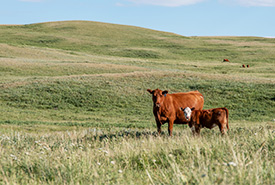
Range health assessments help determine how many cattle can graze an area sustainably. (Photo by Leta Pezderic / NCC Staff)
One of the people helping to achieve this balancing act is Lee Moltzahn, NCC’s Rangeland Resource Manager. Lee works to determine how many cattle a property can support sustainably and what management actions might be needed to keep grasslands healthy.
“It’s a balancing act between being a detective, by searching for clues that tell the story of past and current management, and then working with lessees and landowners to achieve realistic outcomes,” says Lee. “It's no wonder range management is often referred to as both an art and a science.”
One piece at a time
Central to Lee’s work are range health assessments, a type of field survey. These look at five different aspects of the range, one plot (the area contained within a 20 by 50 centimeter metal frame placed on the ground) at a time.
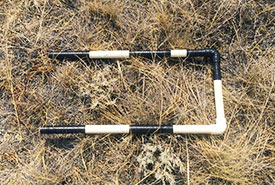
A frame used to delineate a range health plot (Photo by Lee Moltzahn / NCC Staff)
Each assessment is an indicator of range health, a concept referring to the ability of an area to perform key ecological functions. These include plant diversity and productivity, water retention and release, nutrient and energy cycling, and soil stability.
For each given property, these assessments are performed across varying topography and soil types. They consist of many plots, covering different plant communities and pastures (sub-areas separated by barriers such as fencing). Each plot is like an individual puzzle piece, that when all fit together, builds a picture of the ecological health of the property.
Enjoying this story? Sign up for our newsletter!
Plants paint a picture
While assessing an area of the same soil type and topography, the first thing Lee looks at is plant composition. This refers to what plant species are contained in plots and the relative proportion of each. Lee therefore must be an expert at identifying the dozens of grass species found throughout Alberta grasslands, as well as hundreds of other plant species.
“Plant identification is crucial to determine whether the diversity of species you are seeing is what it should be,” says Lee.
Lee compares the composition he sees to what is called the reference plant community. This represents the best-case scenario for a particular type of soils and aspect under optimal management.
Plants respond differently when livestock and wildlife eat them. Some plants, known as "increasers," become more common when animals graze on them. On the other hand, there are plants called "decreasers" that become less common when grazed upon.
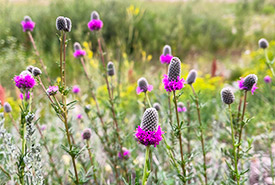
Purple prairie clover, typically an increaser species (Photo by NCC)
Generally, a greater abundance of decreasers is a sign of healthy range, whereas finding more increasers could show a pasture is being overgrazed.
"Often your more desirable grass species are the ones most sensitive to increased grazing,” says Lee. “As the decreasers are filtered out, over time, you will see species resistant to heavier grazing increase.”
Lee then examines plant structure, which refers to the different layers of plants growing on the site, varying by height, size and root depth. These range in order of increasing height from the ground layer of mosses and lichens to the low grasses and forbs layer, then the tall grasses and forbs layer and finally the low shrubs layer.
The structure of the reference community varies regionally, and is related to climate, soils, and topography.
“If you’re in southeast Alberta for example, you would not expect many shrubs, whereas if you are in the foothills, you would expect a lot more willow,” says Lee.
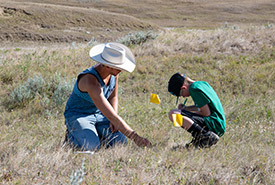
Range health training at Youth Range Days (Photo by Leta Pezderic / NCC Staff)
Grazing affects these different structural layers. For example, many decreaser species are mid and tall grasses, so that structural layer is often reduced as grazing intensity increases. The low moss and lichen layer may also be reduced if it is trampled repeatedly by livestock.
It’s not just native species that are noted. Lee also investigates the presence of invasive species, many of which become more abundant when an area is disturbed.
Click here to learn more about our efforts to conserve grasslands!
A good type of litter
Another indicator the range health assessment examines is “litter,” which refers to the decaying plant matter from previous growing seasons that accumulates on top of the soil.
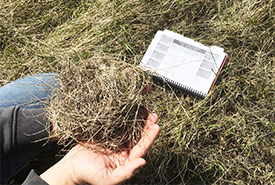
Grass litter measured during a range health assessment (Photo by Lee Moltzahn / NCC Staff)
Litter is important, because it acts to protect the soil by keeping it moist and cool. It also slows water runoff and helps the soil retain nutrients.
“If you were to visit a grassland site on a very hot day and stick your hand underneath that litter, it will still be damp,” says Lee. “Without that litter layer, the soil will be as hot and dry as the surrounding air.”
The more exposed the soil, the more likely it will erode in the unrelenting winds or violent rainstorms of the prairies. However, too much litter is also not desirable, as it can choke out other plants, reducing biodiversity and allow invasive species to infiltrate an area.
The amount of litter is a result of grazing intensity: an area that is undergrazed accumulates excess litter, while an area that is overgrazed will not have enough.
Keeping soil put
The final indicator is looking for signs of erosion. As cattle walk across the landscape, they tend to form trails. If these trails are used frequently enough, this will disrupt vegetation, and start causing erosion of the topsoil.
“With bison and cattle, you are going to expect to see some erosion,” says Lee. “But if it’s really excessive, you may begin to observe well-defined trails where it’s worn down to the dirt.”
Looking at the big picture
Once the health assessments are complete, the information gathered informs management recommendations Lee suggests.
“Once we collect all that data and compare it with historical knowledge and wildlife information, we can come up with a plan that is both holistic and realistic,” says Lee.
If there are signs an area is overgrazed, it might be time to dial back the number of cows allowed in the area. But recording some plots with lower health scores is expected, and no real cause for concern.
“You don’t panic, because you look at the ranch as a whole,” says Lee.
If some areas show reduced health, there are tools that can be used to adjust where the cattle move around the landscape.
One such tool are minerals, which are salts cows cannot resist.
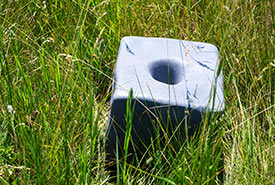
Mineral licks are used to direct cattle to an area (Photo by NCC)
If an area is difficult for the cattle to reach, and as a result is undergrazed, a mineral feeding station can be deployed there to help entice them to visit. Or if the cows are concentrating in a certain area, placing a few mineral stations evenly throughout the pasture can help spread them out.
Another tool is exclusion fencing, which is small temporary fencing that can be used to prevent cattle from entering areas that are more vulnerable to disturbance with increased use, such as riparian areas. Off-site watering is another option to make sure cows stay out of features like wetlands or creeks.
Over time, it is expected that these managed grasslands will represent a “shifting mosaic” meaning that the health of various locations will change over time, like the way it once was.
Cattle will preferentially graze certain areas, but then will shift away as those plant communities change in response to that grazing. Then, those heavily grazed areas will recover from that higher intensity and grow back over time.
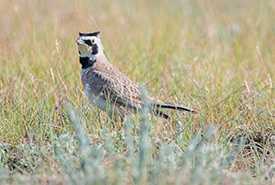
Horned lark, a grassland songbird, prefer more heavily grazed areas (Photo by Jason Bantle)
“When there is some variability in that scoring and plant community, that is not a bad thing in terms of biodiversity and wildlife management,” says Lee. “Grazing helps provide suitable conditions for a greater variety of plants and animals. For example, some species need shorter grass to survive, while others need longer grass.”
By working together with livestock producers to support sustainable management practices on these lands, we can help protect biodiversity.




